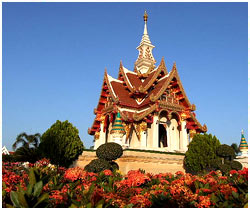City Pillar Shrine of Bangkok originally held a single pillar (Lak Muang) placed by King Rama I, leading to it also being known as San Lak Muang. It was carved out of cassia wood, known as 'Chaiyaphruek', and was 75 cm thick and 27 cm high. However, under the regime of Rama IV, a new pillar was instated in place of the rundown old
 pillar. It was also
made of cassia wood and was 270 cm in height, with a wide base of 175
cm. Moreover, the shrine was refurbished to a pavilion with a
Prang-shaped spire to shelter it. The establishment of this shrine saw
the fabrication of various other shrines in many neighboring places of
Bangkok.
pillar. It was also
made of cassia wood and was 270 cm in height, with a wide base of 175
cm. Moreover, the shrine was refurbished to a pavilion with a
Prang-shaped spire to shelter it. The establishment of this shrine saw
the fabrication of various other shrines in many neighboring places of
Bangkok.According to local beliefs, City Pillar Shrine has the power of granting wishes. Therefore, many people visit the shrine to seek blessings from the Divine. People genuflect on the foot of the pillar, girdled with a dazzling pavilion. Devotees, whose prayers sees fulfillment, hire traditional dance troupes & organize dances free of cost for the public. It is a way of showing their gratitude to the foundation spirit of the shrine. Apart from the pillars, the place also enshrines images of various protective deities, making it a popular religious visitation of Bangkok.



